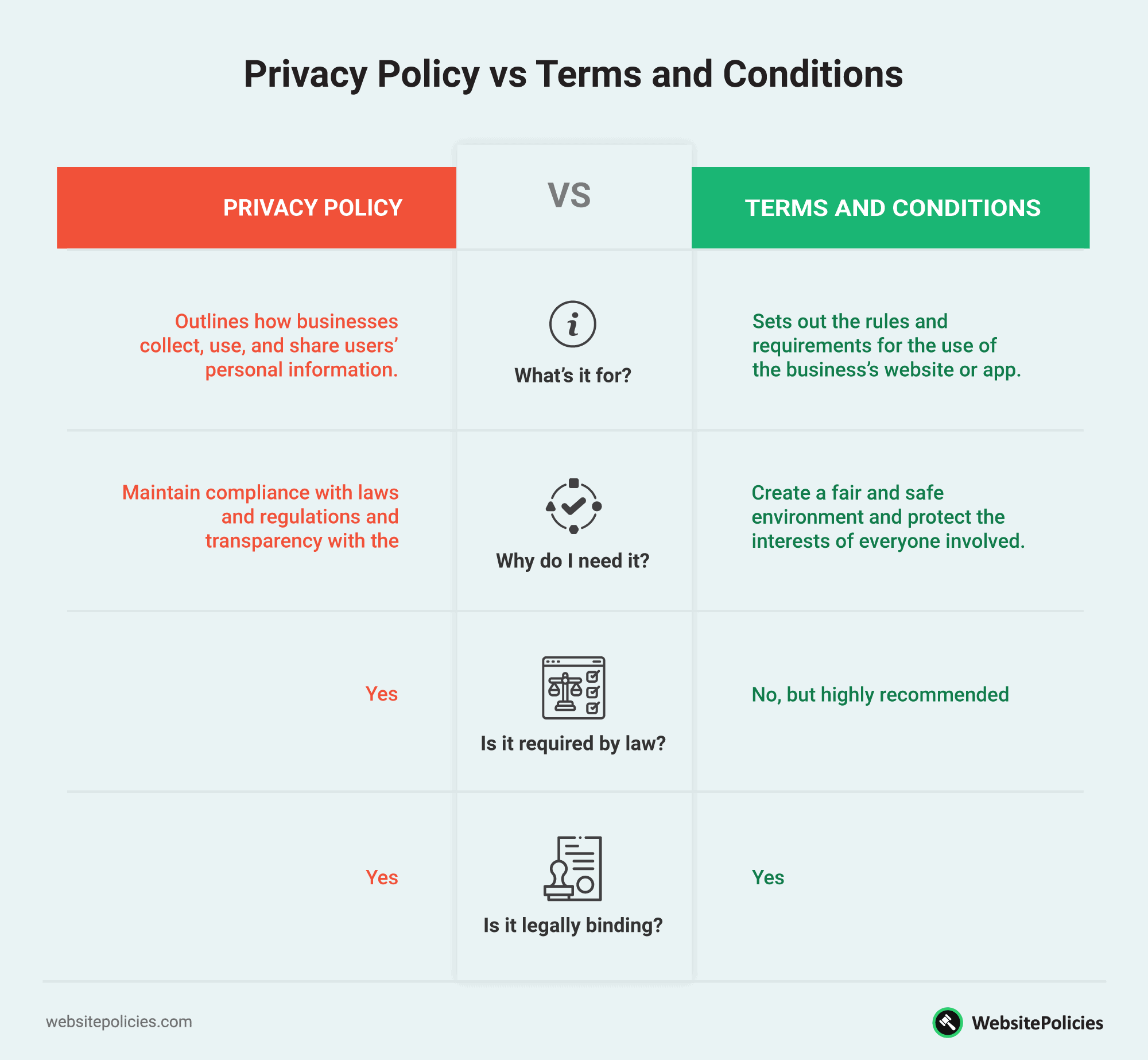When you are launching a website or a mobile app, you need to take a lot of steps to make sure that you successfully get it off the ground and set it on a path that will bring you profit and help you meet the needs of your future customers.
One of the most important steps to take when launching a website or a mobile app is creating terms and conditions and privacy policy agreements.
These legal agreements are incredibly valuable for both you and your customers, because not only do they inform people about everything that they are agreeing to when they start using your services, but they also protect your company against legal claims.
However, many websites and mobile app owners don’t quite realize the difference between terms and conditions and privacy policy agreements and they don’t really know how to draft them, so they end up making their business vulnerable.
Since they have different purposes, you need to make sure that you fully understand what each of them is and why you really need them, so read on.
Table of Contents
PRO TIP: Take the hassle of writing your own privacy policy away with our privacy policy generator trusted by over 200,000 businesses. It’ll save you hours of work and possible costly legal mistakes.
What is a Privacy Policy For?
A privacy policy is a legal document that informs your users about the collection, storage, sharing, and use of their personal information. This is required by law, so you should never skip this step before you actually launch your website or mobile app.
If you collect, store, and use any kind of personal information from your website or mobile app users, you must create a proper privacy policy agreement to let them know that you will collect and use that information.
A privacy policy should not only merely inform your users of the fact that their personal information will be collected and used when they start using your services.
It also needs to let them know exactly what information will be collected and how, as well as how and for what purposes it will be used.
It’s required by law in many countries, should be clear and easy to understand, and updated regularly depending on your business practices.
In Europe for example, the General Data Protection Regulation (or GDPR for short) requires companies that collect any personal information from individuals in the EU to have a valid privacy policy.
So even if your business is not located in Europe, chances are you may have customers from there in which case you need to comply with GDPR’s requirements.
ALSO READ: Download a Sample Privacy Policy Template
If your website collects data using specific cookies and trackers, you also need to secure consent from the users and have a valid cookie policy in place.
What is a Terms and Conditions Agreement For?
A terms and conditions agreement, also known as terms of service and terms of use, is a legal agreement that sets forth the rules and requirements that your customers must agree to use your website or application.
Therefore, for people to use your website or mobile app, you need to clearly state what they need to do if they want to use them, as well as what you will do in case of some violations of the rules that you lay out in the agreement.
Your terms and conditions agreement should include your copyright details, your billing, and subscription policies (especially important for SaaS companies), potential warranties on your services, potential modifications of your services, and how exactly your users may use your website or mobile app.
Although this agreement is not required by law, it is highly recommended that you have it, precisely because of limiting your liability, as well as for protecting your company against any potential abuses of your website or mobile app, such as copyright infringement, for instance.
Apart from limiting liability and protecting your business against any kind of abuse, this legal document also enables you to build credibility and trust with your users.
You inform them of their rights and responsibilities towards your company, as well as yours towards them, which shows that you are a trustworthy professional.
Just like with your privacy policy, you need to let your users know about the potential modifications of your terms and conditions.
Of course, the full scope of what you include in your terms and conditions agreement depends on the nature of your business, your products, and your services so don’t forget to mention everything that’s important to you.
That’s why it’s important to have terms and conditions available regardless of what kind of online business you’re operating.
Without one, you have very few options when it comes to enforcing the rules or protecting yourself from certain types of liabilities.
Single or Separate Agreements?
Some website and mobile app owners combine their privacy policies and terms and conditions into a single agreement. What they usually do is incorporate their privacy policy into their terms and conditions agreement by creating a separate section for it.
I don’t suggest doing so as it makes the already long and complex agreements even longer and even more complex.
As such, it’s highly recommended to keep all of your legal agreements separate from each other. Not only is it easier for your customers to navigate through them, but it’s also much easier for you as well to keep them up to date.
You can choose to reference your privacy policy document in your terms and conditions agreement, providing a link leading to the full document, and vice versa. That way, you inform your users that there is another legal document that they need to be aware of, in case they have perhaps overlooked it.
Keeping your legal agreements separate also lets your users know that each of the documents has a completely different purpose. It also helps them comprehend and retain all of the information more easily.
At the end of the day, you can always interlink the documents if you need to refer to certain clauses.
Comparison Chart
Here’s a brief comparison chart for privacy policy vs terms and conditions to make it easier to view the purpose and differences.

Frequently Asked Questions
Do your customers have to agree to your privacy policy?
They don’t have to agree to your privacy policy but in most cases, they won’t be able to use your products or services fully.
Can you use a template for a privacy policy or terms and conditions?
Yes, you can use a template to make these documents. Just remember to personalize them according to your business as most are rather generic.
Do you need a lawyer to draft these documents for your business?
A lawyer does not have to be involved when drafting a privacy policy and terms and conditions but you may still have them review the final documents if you prefer.
Can you copy another website’s legal policies?
Copying legal policies from someone else is bad practice for many reasons. First of all, it’s considered plagiarism, and secondly, it’ll likely not even cover your business properly as you may be unaware of certain things in those policies.



